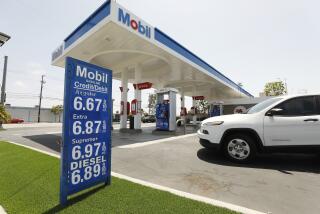Gasoline Price Hikes Fail to Brake a Nation of SUVs
- Share via
Flush with cash and armed with sport-utility vehicles, U.S. motorists are burning through lots more gasoline even though they are paying lots more at the pump, industry and government figures show.
Drivers’ thirst for fuel was such last year that the growth in demand nationwide was the size of Virginia’s entire consumption for 1999 at nearly 10 million gallons a day, industry analyst Trilby Lundberg said.
And the fuel slurping does not appear to be slowing, with AAA forecasting that record numbers of Americans will hit the highways this summer.
A decade ago, economists were predicting that gasoline consumption would be shrinking right about now because of improvements in fuel efficiency.
But a white-hot economy--replete with new jobs and pay raises and stock market gains--and the unforeseen popularity of those gas-hungry SUVs have turned the consumption picture upside down.
“People are feeling pretty affluent these days,” said David Cole, director of the University of Michigan Office for the Study of Automotive Transportation. “We’re fiddling while Rome burns. I guess at some point we will be concerned about this.”
Americans not only are driving bigger cars and trucks, they’re putting more miles on them, approaching 12,000 miles a year on average, up from a little more than 11,500 in 1997, according to the Federal Highway Administration.
Although higher gasoline prices provoke an immediate emotional response, Cole and other experts predict that it would take a serious recession or gasoline shortages and lines at service stations to drive motorists to downshift their consumption.
Neither is considered very likely.
All this gasoline use alarms environmentalists but does not particularly disturb economists, who see it as a symptom of a healthy economy and not a harbinger of another energy crisis.
“This is just one more sign of the good times. . . . It’s neither bad nor good, it just is,” said Newport Beach-based energy economist Philip K. Verleger Jr. “As consumers’ incomes rise, they choose to spend their funds on increased mobility.”
Such spending translated into a 2.8% increase in gasoline consumption nationwide last year even though prices rose 10% in 1999, said Lundberg, whose Camarillo-based research firm produces a closely watched biweekly gasoline price survey. The increase brought consumption to nearly 130.9 billion gallons last year, or 358.6 million gallons a day.
The Energy Department pegs U.S. gasoline consumption growth for the year at a slightly lower 2.2%.
U.S. motorists burned nearly 10 million gallons of gasoline more each day in 1999 than the year before, the biggest increase of the decade, Lundberg said. In California, where prices rose much higher than the rest of the nation, consumption was up 2%, she said.
The increase comes at a time of growing use of public transportation across the country. Ridership on trains and buses rose 4.5% in 1999 to 9 billion trips, the highest level in 40 years, according to the American Public Transportation Assn.
In Southern California, overall commuting patterns have changed little in the last 10 years, with about 77% of commuters driving alone, 15.5% using carpools or vanpools and 3.5% taking the bus, said a spokesman for the Southern California Assn. of Governments, a research and planning group for the six-county region.
Metrolink--whose 124 trains in Southern California serve commuters with long hauls, an average of 64 miles round-trip--has seen a 14% increase in ridership in the last year, probably because of higher gasoline prices, a spokeswoman said.
Gasoline prices, which hit historic inflation-adjusted lows in late 1998, began rising last year because oil-producing nations decided to pump less crude.
Since April 1, the Organization of Petroleum Exporting Countries, along with nonmembers Mexico and Norway, have increased production, causing oil and gasoline prices generally to decline.
Oil futures prices and U.S. average retail gasoline prices have risen in recent days, however, on short-term supply concerns.
The average price of self-serve regular gasoline nationwide this week rose 3.7 cents to $1.492 a gallon, though it did fall slightly in California, to $1.633 a gallon, the Energy Information Administration reported Monday.
The current U.S. average price is about 35 cents higher than a year ago and the California price is about 15 cents higher.
High gasoline prices apparently will not slow U.S. motorists this summer. A survey released last week by AAA projects that a record 28.4 million people will be traveling this summer by car, light truck or recreational vehicle, up 3% over 1999.
“People seem to want to drive just as they always have,” AAA spokesman Geoff Sundstrom said. “Price increases have never been enough to dissuade people from taking their traditional summer road trip.”
Gas consumption has been rising for many reasons besides the fatter wallets of many motorists. More drivers are on the road every year, the average driver is driving more each year and most commuters have little flexibility in how much they drive, said Dave Costello, an economist with the Energy Information Administration, the Energy Department’s research arm.
“People have to get to their jobs or school or whatever,” Costello said. “You can cut back on your driving only somewhat.”
On top of all that, Americans are driving bigger vehicles. SUVs and other light trucks, which typically are less fuel-efficient than passenger cars, now account for about half of all new-vehicle sales.
“These things were built for hauling hay, and now they haul home people in worsted suits carrying lattes--and only one of them at a time,” said Daniel F. Becker, director of the Sierra Club’s global warming and energy program.
Becker said he finds the gas consumption growth figures “alarming and they are a symptom of the problem, but they show that we can make a difference by requiring gas-sipping technology” on SUVs and other light trucks.
The Sierra Club wants Congress to remove a rider from a transportation appropriations bill that blocks new, tougher fuel-economy standards for passenger vehicles. Average fuel economy for all passenger vehicles has been declining since 1996 because of brisk sales of light-duty trucks, Environmental Protection Agency data show.
All this gas gulping does have some energy policy specialists concerned.
“Anything that makes us more dependent on foreign oil is a bad call,” said Rob Schlichting, a spokesman for the California Energy Commission. “[Our] policy has always been that we should have a diversified portfolio of fuels.”
Current global consumption of oil is about 76 million barrels a day. Excess production capacity amounts to about 3 million barrels a day, or only 4%, said economist Alan H. Struth.
With increasing investment in exploration and production, that capacity should grow, said Struth, former chief economist at Phillips Petroleum Co. and currently an economist at Honeywell Hi-Spec Solutions, a petroleum consulting firm in Houston.
In any case, the world will not run out of oil any time soon, as technological advances will aid the discovery of new deposits, he said.
“There’s still a lot of oil out there in the ground to be found,” Struth said. “Every year there are new fields coming on.”






